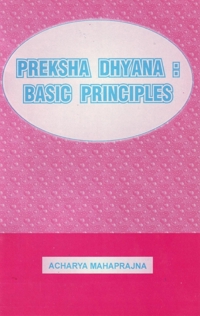Initiation
At the commencement of the meditation session, all sãdhakas shall assume a posture of cross-legged position, totally relax the body and mind to remove the tension, and with folded hands, recite the following aphorisms:
1. abbhuṭṭhiomi ãrãhaṇãe
I dedicate myself to the practice of Prekshã-Dhyãna.
2. maggaṁ uvasaṁpajjãmi
I initiate myself into the path of Spiritual Practice.
3. samattaṁ uvasaṁpajjãmi
I initiate myself into the practice of Internal Perception.
4. saṁjaṁaṁuvasaṁpajjãmi
I initiate myself into the practice of Spriritual Experience.
Thus the sãdhakas initiate themselves into the practice of prekṣã-dhyãna.
Five Disciplines of Initiation
1. Bhãvakriyã (Synchrony of Mental and Physical Actions):
This is three-fold:
- Present-mindedness
- Complete awareness of one's actions.
- Un-interrupted (spiritual) vigilance.
Present-minded action is contrary to mechanical (absentminded) action. When one is engaged in doing some thing, it is not proper to be carried away by one's imagination which is not connected with the work in hand.
Habitually, one wastes his time and energy in useless recollection of the past or irrelevant imaginations of the future. But neither the past nor the future is real. Only the present exists and is real. One who lets the present slip away, is never able to re-capture it, and hence, Bhãvakriyã is the only means of capturing the reality of the present. It means present-minded action.
Bhãvakriyã also means complete awareness of one's action. Habitually, again, one thinks with 'half a mind', that is fracturing the mind, and engaging only a piece of it in the work in hand, while the rest of it is allowed to wander about. When the mind is totally engaged by the work in hand, the result is Bhãvakriyã. Synchrony of mind and body saves much waste of efforts and energy, increases efficiency and results in greater success.
Another meaning of Bhãvakriyã, is constant vigilance. One must be continuously aware of his ultimate aim, which is twofold: (a) Purification of mind and (b) Awakening the supine Will and other inherent powers.
2. Act—Do not "Re-act"
Habitually we react to external stimuli, that is, we are generally overwhelmed by retaliatary emotional forces within us demanding appropriate action. But, surely this cannot be called "action"; it is, in fact, "re-action". Discipline of the reasoning mind controls the re-active forces and results in appropriate "action", rather than "re-action". One should endeavour to establish control and avoid retaliatary behaviour.
3. Amity
Behaviour of a sãdhaka should radiate friendliness, compassion and sympathy. This is possible only when one is able to countermand one's reactive tendencies by reasoning and avoid retaliatary thoughts and actions. Subjugation of retaliatary impulse results in friendly and compassionate behaviour. The sãdhaka should be ever vigilant in this respect and cultivate amity.
4. Dieting
Dietics is an important facet of meditational practice. Intake of food deeply influences not only our physical health, but also mental tendencies and emotional states. Habitually we eat too much. This overloads our digestive system and results in indigestion etc. This in turn, further weakens not only the digestive organs but vitiates the entire organism, including mental tendencies and emotional states.
Sãdhaka should be vigilant towards his diet, avoid over-eating. He should particularly abstain from such foods and drinks as are unsalutary to one's health, physical as well as mental.
5. Silence
The last discipline of the initiation is—controlled speech or complete silence. We speak in order to communicate with one another. However, habitually we speak too much and too long. Sãdhaka should be careful to effect full control over his speaking mechanism. It should be used only when necessary. His speech should be modulated and measured.
Recitation of Arham
A precondition of meditational practice is a build-up of a defensive armour to protect the practitioner from the onslaught of evil influences of external environment. The process of the build-up is repeated loud recitation of the syllable "arham". Synchronised with the recitation, there should be a mental projection of the step by step build-up of the protective shell. The shell is being woven from the criss-cross of the electromagnetic radiations, emanations from the sound waves thus produced. The radiations ultimately merge together and build an impregnable armourlike cover enveloping the practitioner, keeping him safe for the duration of the practice.
 Acharya Mahaprajna
Acharya Mahaprajna

